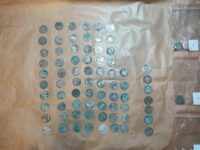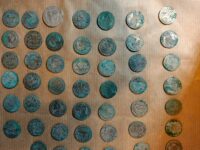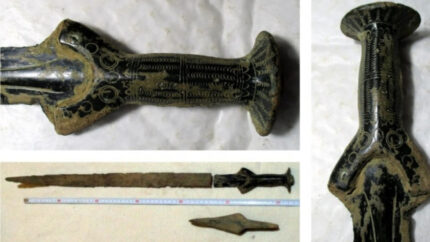It has been a fruitful mushroom-picking season in Eastern Europe. On October 22nd, Bogusław Rumiński took his bike to go mushroom-picking in  his home village of Jezuicka Struga in north-central Poland. While riding along a bumpy road, the bike got stuck in a rut and Rumiński fell over. He put his arm out to break his fall and came up with a handful of six silver coins. When he looked around, he found 60 more of them scattered on the ground.
his home village of Jezuicka Struga in north-central Poland. While riding along a bumpy road, the bike got stuck in a rut and Rumiński fell over. He put his arm out to break his fall and came up with a handful of six silver coins. When he looked around, he found 60 more of them scattered on the ground.
He reported the find to the Provincial Office for the Protection of Monuments in Toruń who dispatched an employee to scan the find site the next day. Another seven coins were discovered. The day after that, archaeologists arrived on the scene to excavate. The dig turned up another 13 coins, bringing the total 86.
 The coins are all silver and date to the second half of the 17th century during the reign of King John II Casimir Vasa (r. 1648 – 1668). The oldest was minted in 1657, the youngest in 1667. They are in different denominations — mostly six-groszy coins, but also larger denominations including 18-groszy coins. They were minted at a turbulent time in the Polish-Lithuanian Commonwealth. The country was mired in the Russo-Polish War (1654-1667) and in the Swedish invasion known as The Deluge (1655-1660). While there is verdigris and other corrosion material on some of the coins, underneath that they look to be in excellent condition, close to mint. Because of this, archaeologists believe they were buried when they were new, likely hidden to keep them from becoming war booty.
The coins are all silver and date to the second half of the 17th century during the reign of King John II Casimir Vasa (r. 1648 – 1668). The oldest was minted in 1657, the youngest in 1667. They are in different denominations — mostly six-groszy coins, but also larger denominations including 18-groszy coins. They were minted at a turbulent time in the Polish-Lithuanian Commonwealth. The country was mired in the Russo-Polish War (1654-1667) and in the Swedish invasion known as The Deluge (1655-1660). While there is verdigris and other corrosion material on some of the coins, underneath that they look to be in excellent condition, close to mint. Because of this, archaeologists believe they were buried when they were new, likely hidden to keep them from becoming war booty.
The coins are now being conserved. When that is complete, they will join the collection of the Jan Kasprowicz Museum in Inowrocław.
Meanwhile, over in the Jesenicko district of Northern Moravia, Czech Republic, Roman Novák took advantage of ideal fungi-hunting weather after the rain to look for mushrooms in the woods near his home when he came across a piece of metal sticking out of some stones. He dug it up and found a sword. He dug some more and found a bronze axe.
Mr. Novák immediately contacted archaeologists who have since conducted several tests. These show that both the sword and axe date back to around 1,300 BC and resemble weapons used mainly in the area of what is today Northern Germany, says Jiří Juchelka, who leads the archaeology department at the nearby Silesian Museum.
“The sword has an octagonal handle. It is only the second sword of its type to be found here.”
Experts say they were surprised to find such a sword in the Jesenicko area, because, at the time, it was sparsely populated. However, tests on the soil show that it is indeed local.
It was made of bronze and cast in a mould rather than hammered like the much-stronger iron blades that followed them. The quality of the casting of this sword was fairly low. X-rays found the blade metal was replete with small bubbles which would have made it flimsy for combat. It may have been ceremonial or symbolic.
The find site will be archaeologically excavated and the sword and axe studied. When analysis is complete, the artifacts will be exhibited at the Ethnographic Museum of Jesenicko and the Silesian Museum.
